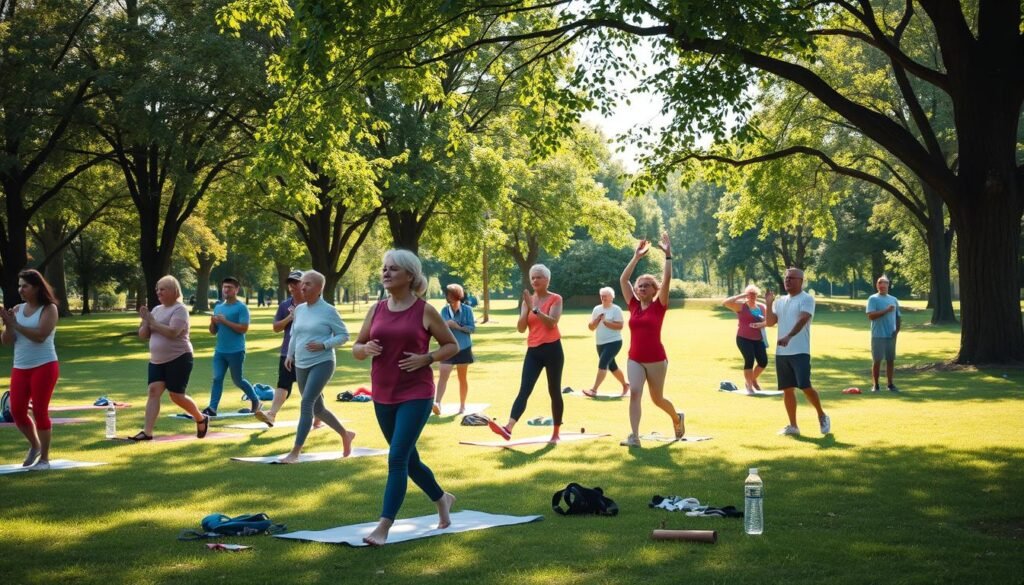Lung cancer is the top cause of cancer deaths worldwide. It shows the big need for support for those affected. But there’s good news. Studies show that exercise plays a big role in helping. Patients doing regular exercise see less fatigue and better life quality.
They also breathe easier and recover better. This is key not only for getting through cancer but also for living well after.
The lung cancer exercise guidelines stress the need to move, especially during treatment or recovery. Even simple activities like walking help a lot. Movement brings both mental and physical benefits. This article talks about how exercise helps and gives advice for patients wanting to get active.
Key Takeaways
- Lung cancer is a leading cause of cancer-related death, but exercise can improve outcomes.
- Physical activity enhances quality of life, reduces fatigue, and strengthens the body.
- Regular exercise can lead to significant psychological benefits for lung cancer patients.
- Guided exercise programs can offer targeted improvements in fitness and well-being.
- Consulting healthcare providers is essential for safe and effective exercise planning.
Understanding the Importance of Exercise for Lung Cancer Patients
Exercise is vital for people with lung cancer. It helps them handle and bounce back from treatments like chemo and surgery. Not just physical strength, it also fights the fatigue that comes with treatment.
Working out is great for the mind too. It lowers stress and makes you happier. Plus, it can help improve sleep and fight off depression. It can also get you to eat more when your appetite is low.
Simple activities like swimming, walking, or light jogging are good for the heart. They don’t tire you out too much during treatment. Lifting weights is also key for muscle rebuilding and improving balance and bone health.
Studies show exercise battles fatigue and lifts the life quality for those fighting lung cancer. Stretching helps with moving better and breathing deeper. It boosts blood flow as well.
Before starting any exercise, talking to a doctor is a must. This makes sure the chosen activities are safe. This way, they enjoy working out without risks.
For more on exercise plans, check out this resource.
Benefits of Physical Activity for Lung Cancer Survivors
Being active has many benefits for people who have had lung cancer. Studies show that exercise improves life quality for these survivors. It helps not just with physical health but also emotionally and mentally.
Exercise is great for fighting cancer-related tiredness. Many with lung cancer feel really tired, impacting their everyday life. By exercising, they can feel more energetic and lively. Sadly, most lung cancer survivors are not as active as they should be.
Also, being active is good for your mind. It leads to fewer feelings of sadness and worry. By feeling stronger mentally, survivors are more likely to keep exercising. Lifting weights helps keep muscles strong and fights some treatment side effects.
Simple activities like walking or yoga are good options. They help survivors stay fit and find community support. Group activities can inspire people to exercise more. Using tools like pedometers can keep them motivated.
Research keeps showing how great exercise is for those who’ve had lung cancer. It makes them move better and feel less tired. Plus, it boosts mental health. Staying active is key to living longer and better after cancer.
Consulting with Your Care Team Before Starting an Exercise Program
Before starting an exercise program, lung cancer patients should talk to their care team. It’s important because doctors can create a workout plan that fits with the patient’s health and treatment. This way, the exercise program will be safe and helpful, focusing on the patient’s needs during recovery.
The care team helps to spot any exercise limits a patient might have. They make a plan that’s just right in how often and how intense exercises should be. They might use guidelines from the American College of Sports Medicine, which recommends at least 150 minutes of exercise a week for cancer survivors.
Checking in with the care team regularly lets them change the exercise plan as needed. This team effort makes sure that patients can work out safely. It helps improve their physical strength, function, and overall quality of life.
Having a care team help plan your exercise routine creates a safe exercise space. It also provides support to keep going and recover better.
Lung Cancer Exercise Guidelines
Following lung cancer exercise guidelines is key to boosting health and handling symptoms. But patients may worry about exercise. They fear getting more tired, having trouble breathing, and not being physically able. Tackling these issues helps make exercising better and safer.
Addressing Common Concerns About Exercise
Lung cancer patients often think exercise might make their condition worse, especially with side effects from treatment. Acknowledging these fears matters a lot:
- Fatigue management: Starting slow with easy activities can help avoid too much tiredness.
- Breathing concerns: Using breathing exercises in routines can make the lungs work better and feel more comfortable.
- Physical limitations: Focusing on what they can do, patients can slowly do more, focusing on their abilities.
Creating a Personalized Fitness Plan
Building a fitness plan that suits the person’s health can make exercising more effective. Working with experts like exercise physiologists helps. They can create a plan that fits with the patient’s fitness and health goals. This plan can really help:
- Setting realistic goals based on what the person can actually do.
- Combining aerobic and strength exercises for total health benefits.
- Changing how often and how hard they exercise as they improve and feel better.
Studies show that custom exercise plans improve how well people can exercise and their life quality. Joining a program for six to twelve weeks with a pro’s help has good results. This shows how crucial lung cancer exercise guides are, taking personal health into account.

Starting Slowly: Adjusting to Exercise During Treatment
Starting to exercise during cancer treatment can be tough. It’s best to gradually work your way into a starting exercise program. Taking it “low and slow” helps your body adjust without too much fatigue or discomfort.
Low-Intensity Activities to Consider
For beginners, it’s important to do low-intensity activities. You can try:
- Easy walking
- Light stretching
- Gentle yoga
These help you stay fit and improve your mood. They are a great base to prepare for harder exercises as you get stronger.
Monitoring Your Energy Levels
It’s key to check how tired you feel when getting treatment. Seeing how you react to different exercises helps tailor your fitness plan. Writing down your energy levels every day can show when to adjust your activities. This also makes it easier to talk to your doctors about how you’re doing.
Knowing how exercise affects health is crucial for those who’ve had cancer. For more info, especially on how exercise relates to lung cancer screening, looking into resources is helpful.
Aerobic Exercise Recommendations for Patients
Aerobic exercise is very important for lung cancer recovery. It helps the heart and improves the oxygen that gets to the body. People should do 150 minutes of medium-hard exercise or 75 minutes of hard exercise every week.
Doing more exercise is not just about being fit. It also reduces the risk of heart disease and some cancers. Good activities include:
- Walking
- Swimming
- Cycling
Patients should pick activities they like and start slow. They can increase how hard and long they exercise as they get stronger. Working out several times a week is best for lung cancer recovery.
Here are the exercise recommendations for different levels of activity:
| Activity Type | Duration | Frequency | Intensity |
|---|---|---|---|
| Moderate Aerobic Activity | 150 minutes | Spread throughout the week | Moderate |
| Vigorous Aerobic Activity | 75 minutes | Spread throughout the week | Vigorous |
| Additional Benefits | 300 minutes | Weekly | Mix of moderate and vigorous |
Adding this exercise to their daily life helps lung cancer patients feel better overall.

Incorporating Strength Training into Your Routine
Strength training is very important for lung cancer patients. It helps increase muscle strength and lung health. It is key in fighting muscle loss and keeping bones healthy after cancer treatment. Adding strength training to a workout can improve physical strength. This makes life better for patients.
The Importance of Muscle Strength for Lung Health
Building muscle strength with strength training matters a lot. This is because cancer treatments may decrease muscle mass. Research shows regular resistance exercises keep muscle mass. This is important for reducing tiredness and helping with recovery. The Cancer Council Australia says even five to ten minutes of exercise can help those with lung cancer.
Adding strength training helps bring back normal function. It also lowers symptoms like feeling out of breath and tired. This makes daily life easier. Simple exercises after surgery can aid in a smoother recovery. It helps people do everyday tasks better. Experts suggest following a guided exercise plan for the best results.
Many studies highlight the perks of staying active during lung cancer treatment. A steady, personalized strength training plan can lead to stronger muscles and healthier lungs. This means a better life quality. Patients interested in adding exercise to their treatment can find info here.
| Benefit | Impact on Patients |
|---|---|
| Preservation of Muscle Mass | Helps combat muscle wasting and improve strength |
| Enhanced Functional Capacity | Improves ability to perform daily activities |
| Reduction of Fatigue | Alleviates symptoms and enhances overall energy |
| Improved Recovery Rates | Leads to faster recovery post-surgery |
| Better Lung Function | Decreases breathlessness and enhances lung health |
| Increased Survival Rates | Higher levels of activity linked to improved outcomes |
Breathing Exercises and Their Benefits
Breathing exercises are important for lung cancer patients. They help improve lung capacity and lung function. These exercises can also manage shortness of breath and improve overall lung health. Adding different breathing exercises to your daily life brings many benefits.

- Diaphragmatic breathing: Repeat 5 times, focusing on deep abdominal breaths.
- Shoulder rolls: Perform 5 times, enhancing relaxation in the upper body.
- Shoulder blade squeezes: Complete 5 repetitions to increase awareness and mobility.
- Overhead chest stretch: Target 5 stretches to open up the chest area.
- Quick sniffles: Engage in 3 repetitions to stimulate the respiratory system.
- Deep breathing (4-8-8 technique): Do this 3 times, where the inhalation lasts 4 seconds, hold for 8, and exhale over 8 seconds.
Doing these exercises three times a day is important. Morning, afternoon, and evening practice can help a lot. With regular practice, improved lung capacity and function are more likely.
It’s important for patients to feel okay asking their healthcare provider questions. They are available Monday through Friday. By doing breathing exercises regularly, lung cancer patients can improve their life quality and health.
Maintaining Quality of Life through Exercise
Exercise is key to better life quality for those with lung cancer. It helps manage fatigue and boosts mental health during and after treatment. Adopting strategies for regular exercise is useful against fatigue.
Strategies for Fatigue Management
Effective fatigue management improves daily life. Try these methods:
- Set realistic exercise goals: Make goals that fit what you can do.
- Incorporate social activities: Join groups or classes to find support and friendship.
- Prioritize rest: Balance being active with taking breaks to avoid getting too tired.
These steps help balance energy and improve life quality.
Enhancing Mental Well-being with Physical Activity
Physical activity boosts mental health for those with lung cancer. It helps lower anxiety and depression, leading to a more positive recovery. Benefits include:
- Reduced anxiety: Regular workouts can keep anxiety in check.
- Improved emotional resilience: Many feel more emotionally stable and better at coping.
- Community connection: Meeting people who understand can create a sense of belonging.
Regular exercise helps lung cancer patients with fatigue and mental health. It makes physical and emotional challenges easier to manage. This can bring hope to their journey.
Conclusion
Exercise is key in treating lung cancer. It offers more than just physical strength. People who work out regularly feel better overall. They are happier and less stressed. Doctors recommend a mix of exercises that fit each person’s abilities.
Exercise can also help your lungs work better. Programs designed for lung health can boost endurance. They make you stronger too. This fight against the tiredness that comes with lung cancer. Finding support helps make a plan that’s right for you.
Being active makes life better for those with lung cancer. It fights the disease’s physical and mental challenges. Working with doctors and following guidelines is important. It helps patients get healthier and enjoy life more.